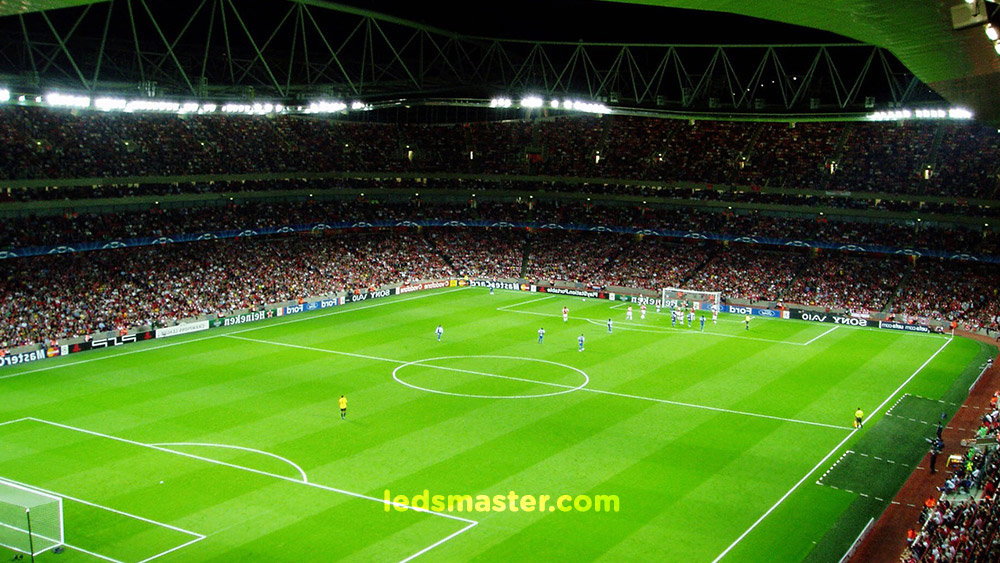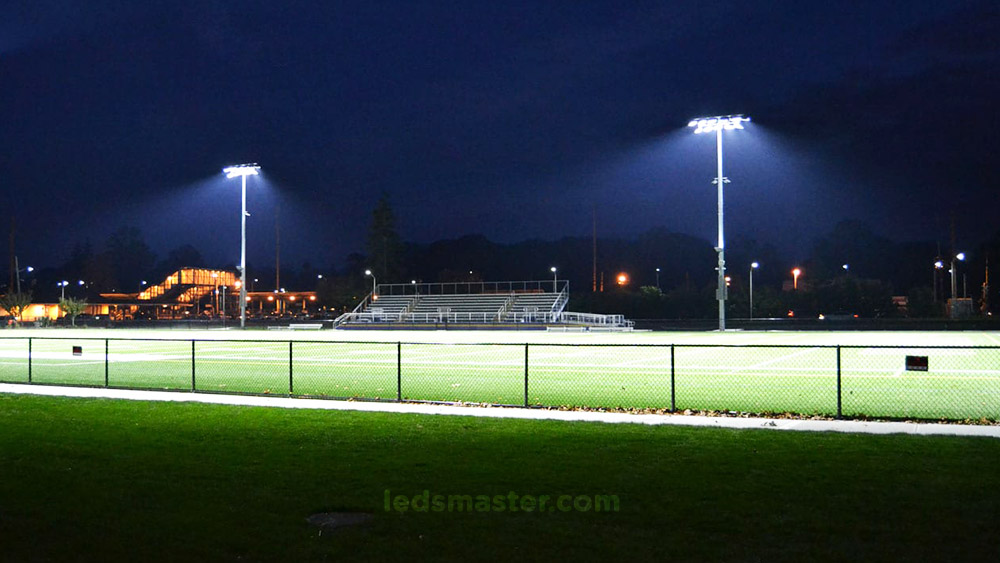Football has long been celebrated as one of the world’s most popular sports, and its appeal continues to expand globally. An increasing number of games are being played at night, driving the need for improved lighting on football fields. This trend reflects not only the growing popularity of the sport but also advancements in lighting technology that enhance the experience for players and spectators. Consequently, understanding how bright football field lighting should be is becoming increasingly important.
Table of Contents
ToggleThe Role of Lumens and Lux in Football Field Lighting
To determine the appropriate brightness for football field lighting, two key measures are often used: lumens and lux. These metrics help ensure that lighting conditions meet the needs of the game and provide a safe and enjoyable environment.
Lumens measure the total amount of visible light emitted by a source. Essentially, it quantifies the brightness of the light itself. The higher the lumens, the brighter the light output.
Lux, on the other hand, measures the intensity of light on a surface area. It accounts for how the light spreads over the field and is influenced by various factors, such as the size of the field, the height and angle of the light poles, and the distribution pattern of the lights. One lux equals one lumen per square meter, making it a more practical measure for understanding how light affects the playing surface.
Brightness Standards for Football Field Lighting

Determining the brightness of football field lighting depends on the level of play and the specific requirements of the field.
Recreational and Training Fields
For basic recreational play or training sessions, it is essential to have adequate lighting to ensure safety and enjoyment. A lighting system that delivers at least 3,000,000 lumens, translating to about 200 lux, is recommended for these settings. This level of brightness provides sufficient visibility for casual play and practice, allowing players to perform effectively while maintaining a safe environment. Additionally, spectators can enjoy the game without straining to see the action on the field, making the experience more pleasant for everyone involved.
Professional Competition Fields
When it comes to professional competition fields, the lighting requirements are significantly more demanding. Fields that host high-stakes matches or professional competitions need a much higher level of brightness to support the intense and fast-paced nature of the game. Typically, these fields require around 22,500,000 lumens, equating to up to 1,500 lux. This increased luminosity ensures that the entire field is well-illuminated, enabling players to perform at their best and allowing television broadcasts to capture every moment of the action with clarity. The enhanced lighting not only supports high-quality play but also elevates the viewing experience for fans both in the stadium and watching from home.
The brightness levels must be consistent across the field to prevent dark spots and provide uniform visibility. Proper lighting enhances players’ performance by reducing eye strain and minimizing the risk of accidents.
Energy Efficiency in Football Field Lighting
With advancements in technology, modern lighting systems not only enhance brightness but also improve energy efficiency. Traditional lighting methods, such as metal halide lamps, are being replaced by more efficient LED lights.
A 400W to 500W LED light can effectively replace a 1500W metal halide light. This switch to LED lighting offers numerous advantages.
Energy Savings
One of the most significant advantages of using LED lights is their energy efficiency. LED lights consume significantly less power while delivering comparable or even superior brightness to traditional lighting options like metal halide lamps. This reduction in energy consumption directly translates into lower electricity bills, making LED lights a cost-effective solution for both residential and commercial applications. Over time, the savings on energy costs can be substantial, offering a quick return on investment.
Longer Lifespan
LED lights are also known for their impressive longevity. Compared to metal halide lamps, LED lights have a much longer operational life, which means they require less frequent replacements. This extended lifespan not only reduces the cost and hassle associated with purchasing and installing new lights but also minimizes maintenance costs. The durability of LED lights ensures that they can provide reliable performance over an extended period, further enhancing their value.
Environmental Benefits
In addition to their financial benefits, LED lights offer significant environmental advantages. The lower energy usage of LED lights contributes to a reduced carbon footprint, making them a more sustainable lighting option. By consuming less electricity, LED lights help decrease the demand for energy production, which often relies on fossil fuels. This reduction in energy consumption plays a crucial role in promoting environmental sustainability, making LED lights an eco-friendly choice for conscientious consumers.
LED technology also allows for better control over light distribution, reducing glare and light pollution. This precision is particularly beneficial for sports facilities located in urban areas or near residential zones, where minimizing light spillage is essential.
How Bright Should the Lights be for a Football Field and Stadium?
To better understand the required brightness levels for a football field, please refer to the table below.
| Type of football field | Brightness of football field lights |
| Recreational and training field | 3,000,000 to 5,000,000 lumens |
| High school and amateur field | 5,000,000 to 10,000,000 lumens |
| National broadcasting football field | 22,500,000 to 30,000,000 lumens |
| International broadcasting and 4K TV, i.e. FIFA, Olympic Games, Premier League, etc | > 22,500,000 to 40,000,000 lumens |
From the table, it is evident that even a recreational football field requires substantial illumination, ranging from 3,000,000 to 5,000,000 lumens. This level of brightness is crucial for providing adequate visibility for casual play and training sessions. However, as the level of competition and the stakes of the games increase, so do the lighting requirements.
Brightness for Professional and Broadcast Fields
For fields designed for high school or amateur matches, the required lumens increase to between 5,000,000 and 10,000,000 lumens. This ensures that the field is well-lit for the players and meets the standards for amateur competition, where the lighting needs to be sufficient to support fast-paced play and ensure the safety and enjoyment of the players.
When it comes to fields used for national broadcasts, the lumens required jump significantly, ranging from 22,500,000 to 30,000,000 lumens. This high level of brightness is necessary to accommodate the demands of television broadcasts and to provide a clear view for the audience both in the stadium and watching from home.
For international events such as FIFA, the Olympic Games, or the Premier League, the lighting requirements are even more stringent. Such fields require more than 22,500,000 lumens, often going up to 40,000,000 lumens. This is essential to meet the standards for high-definition and 4K television broadcasts, ensuring that every moment of the game is captured in detail and clarity.
Number of Lights Required
The substantial lumens required translate into a significant number of light fixtures. For instance, a high school football field may need between 20 to 40 LED stadium lights or 50 to 200 metal halide or mercury vapor lights to achieve the necessary brightness. LED lights are preferred due to their efficiency and lower operational costs compared to traditional lighting solutions.
In the case of professional fields used for events like the Premier League or FIFA World Cup, the number of lights required increases considerably. These fields might need 150 to 250 LED lights or 400 to 600 metal halide or high-pressure sodium lights to meet the demanding brightness levels. This large number of fixtures ensures uniform lighting across the field, eliminating dark spots and providing consistent visibility for players and spectators.
Benefits of LED Lighting
Stadium owners often opt to replace older mercury vapor lights with modern LED lights due to the numerous advantages offered by LED technology. LEDs are significantly more energy-efficient, which means lower electricity consumption and reduced operational costs. They also have a longer lifespan compared to traditional metal halide or mercury vapor lamps, resulting in lower maintenance costs and less frequent replacements.
Moreover, LED lights offer better control over light distribution, minimizing glare and reducing light pollution. This is particularly beneficial in urban areas where controlling light spillage is crucial to avoid disturbing nearby residents.
Are Brighter Football Stadium Lights Always Better?

The question of whether brighter football stadium lights are always beneficial is nuanced. While increased brightness can enhance visibility for both players and spectators, there are also potential drawbacks. Here’s a detailed look at the pros and cons of high-brightness football field lighting.
The Importance of Bright Lighting
Enhanced Visibility
In football, visibility is paramount for both players and spectators. Adequate brightness on the field ensures that the fast-moving football is clearly visible, which is crucial for accurate play and overall enjoyment. For recreational football fields, the recommended lighting levels typically range between 200 to 300 lux. This level of illumination provides sufficient brightness for casual play, allowing players to perform effectively while spectators can comfortably follow the action without straining to see the ball or the players.
Elimination of Shadows
Properly bright lighting is essential not only for visibility but also for eliminating shadows on the field. Shadows can obscure the ball or players, making it challenging to track the game, especially during fast-paced moments. This is particularly important in professional settings, such as FIFA matches, where lighting requirements are much higher, ranging from 1000 to 2000 lux. The increased brightness in these scenarios ensures that shadows are minimized, maintaining clear visibility across the entire playing surface and allowing for a seamless viewing experience.
Broadcast Quality
In the age of high-definition and 4K broadcasts, the quality of lighting plays a significant role in the viewing experience. For televised games, increased brightness is essential to enhance the quality of the broadcast. Higher levels of illumination provide crisp, clear images that capture the rapid pace and fine details of the game. This not only makes the broadcast more enjoyable for viewers at home but also ensures that the nuances of the match are accurately represented, from the players’ movements to the trajectory of the ball.
The Potential Downsides of Excessive Brightness
However, the relationship between brightness and the quality of the viewing experience is not linear. While brighter lights are necessary, excessive brightness can introduce significant issues.
Glare
One of the primary issues associated with overly bright lighting is glare, which can significantly disrupt both players and spectators. Glare occurs when intense light reflects off surfaces or directly impacts the eyes, leading to discomfort and a reduction in visibility. For players, this can translate into missed passes or misjudged plays as they struggle to keep track of the ball and their surroundings. Spectators, on the other hand, might find it difficult to follow the game, as the bright lights can create visual distractions and discomfort. In severe cases, glare can make watching the game an unpleasant experience, detracting from the overall enjoyment.
Eye Irritation
Persistent exposure to strong glare can also lead to eye irritation and fatigue, particularly in environments where lighting is crucial for extended periods, such as during night games. This is a serious concern for both players and spectators. For players, the constant need to shield their eyes from the blinding light can lead to reduced performance, as their focus and reaction times are compromised. Eye strain becomes a common issue, making it harder to maintain concentration on the game. Spectators, too, might experience discomfort from prolonged exposure to glare, leading to eye irritation that can diminish their viewing experience. Properly managed lighting is essential to mitigate these effects, ensuring that both players and spectators can enjoy the game without unnecessary strain.
To address these issues, advanced lighting systems like those developed by LedsMaster incorporate anti-glare technology. Our patented anti-glare system can reduce unwanted glare by up to 90%, allowing for high levels of illumination without the negative side effects associated with glare. This means that even at brightness levels of 1000 to 2000 lux, players and spectators can enjoy a comfortable viewing experience without the discomfort caused by glare.
Striking the Right Balance
The key to effective football field lighting lies in balancing brightness with quality. It’s not just about having brighter lights but ensuring that the lighting is well-distributed and controlled. Here are some considerations for achieving optimal lighting.
Uniformity
Achieving uniform lighting across a sports field is crucial to maintaining optimal visibility and minimizing distractions caused by shadows and glare. When lighting is unevenly distributed, areas of high contrast can develop, creating spots where shadows interfere with the clarity of the game. Consistent lighting ensures that every part of the field is equally illuminated, allowing players to see the ball and each other clearly, regardless of their position. This uniformity not only enhances the quality of play but also ensures that spectators have a seamless viewing experience.
Directional Control
Effective sports lighting relies on precise control over the direction of light. Using fixtures that allow for directional control helps reduce light spill, which occurs when light extends beyond the intended area, causing unnecessary brightness and potential distractions. By focusing illumination precisely where it is needed most—on the playing field—lighting systems can enhance visibility for players while minimizing the impact on surrounding areas. This approach also contributes to energy efficiency, as light is not wasted on areas where it is not required.
Color Temperature
Selecting the appropriate color temperature is another important factor in sports lighting. The color temperature of lights affects not only the quality of illumination but also the comfort of players and spectators. Cooler color temperatures are often preferred for sports lighting because they provide a brighter, more daylight-like quality, which enhances visibility without causing eye strain. This type of lighting helps players see the ball and their surroundings more clearly, while also offering spectators a more vibrant and engaging viewing experience. Choosing the right color temperature ensures that the lighting is effective and comfortable for everyone involved.
Technology
Modern LED lighting systems bring advanced features that significantly improve the lighting experience in sports venues. These systems often include dimming capabilities, allowing for adjustable lighting levels to suit different events or times of day. Instant-on technology ensures that lights reach full brightness immediately, eliminating delays and ensuring consistent illumination throughout the game. Additionally, LED lights offer superior energy efficiency, reducing operational costs while providing high-quality lighting. These technological advancements create a comfortable, adaptable lighting environment that meets the diverse needs of various games and events, making them a valuable investment for sports facilities.
Conclusion
Football’s popularity is soaring globally, leading to more night games and a heightened demand for advanced field lighting. The right balance of brightness, measured in lumens and lux, is essential: recreational fields need 3,000,000 to 5,000,000 lumens, while professional fields require up to 30,000,000 lumens for broadcasts. While bright lights improve visibility and eliminate shadows, they can cause glare. Advanced anti-glare technology, such as that from LedsMaster, reduces glare by up to 90%, ensuring a comfortable viewing experience. Modern LED systems not only enhance visibility but also offer energy efficiency and lower maintenance costs, supporting football’s growth worldwide.

